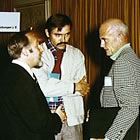
Dr. Charles Dotter in LIFE Magazine (1964)
Who is that mad scientist in the 1964 issue of LIFE magazine? Oh, just the man who invented the concept of angioplasty; in fact he’s the man who actually coined the word “angioplasty!” And he’s the doctor who performed the first angioplasties in the leg, in order to save limbs from amputation without resorting to surgery.
Like many innovators, he had a crazy idea: to open blocked arteries from the inside out. No cutting, suturing, or stitching. Less trauma, lower morbidity, quicker recovery. His name was Charles Dotter and he was a radiologist in Portland, Oregon who, 51 years ago next week, performed an angioplasty on the blocked leg artery of an 82-year-old woman.
Her toes had become gangrenous and there was an non-healing ulcer. Amputation was recommended by the vascular surgeons at Oregon Health Sciences University, but the woman refused. Given the dire prognosis and the patient’s refusal for amputation, the surgeon decided to let Dr. Dotter see if he could do something. And he did. On January 16, 1964, Charles Dotter imaged the patient and saw that she had a short blockage in the superficial femoral artery (SFA), not far from the needle puncture used for imaging. He proceeded to slide a series of catheters through the blockage, from narrow to wider, one after the other, slowly dilating the area that was blocked. And it worked! The stenosis was opened, on the catheterization lab table, without surgery.
As for the patient, the pain stopped in about a week and the ulcer healed completely. Her foot no longer required amputation and follow-up angiograms showed that the artery had stayed open.
This seminal and successful event was the beginning of interventional radiology and cardiology. But you wouldn’t know it because Dotter’s ideas were rejected out-of-hand by the vascular surgical community in the United States; he was, in fact, dubbed “Crazy Charlie.” Thus the photos in LIFE magazine.

Drs. Zeitler, Gruentzig, and Dotter in Nuremburg
But European doctors, specifically Eberhardt Zeitler of Germany, visited him in Portland and brought his techniques to Europe. There a young angiologist named Andreas Gruentzig met Zeitler and came up with the design for adding an expandable balloon to the catheter. Within a few years, with the support and help of Dr. Richard Myler of San Francisco, Gruentzig performed the first coronary angioplasty in 1977.
While Dotter’s treatment for blockages in the leg worked, they did tend to close up over longer periods of time. And more complex narrowings didn’t respond as well as one might expect. Coronary angioplasty was initially much more successful and durable than its peripheral counterpart.
Until recently.
Back in October, and now just yesterday, the FDA has approved a new class of device for the treatment of peripheral artery disease: the Drug-Coated Balloon, or DCB. The latest device, Medtronic’s IN.PACT Admiral, showed a reduction in the number of patients who needed to have the blockage re-opened: from one in every five to only one in fifty!
And the technology to accomplish this success is quite a bit more sophisticated than Dr. Dotter’s somewhat primitive series of concentric catheters. Just check out the video on our news article announcing the FDA approval of the IN.PACT. Hydrophilic Urea? Hydrophobic? Lipophilic? Paclitaxel? Microtubules and DNA replication? Yes, this field has come a long way since 1964. For verification of this fact, check out the following video clip from a film made and narrated by Dr. Charles Dotter for the purpose of educating others about what he’d accomplished. Primitive, yes – but Dotter laid down the principles and concepts that revolutionized the treatment of atherosclerosis.
By the way, if anyone is still interested in these somewhat obscure historical issues, check out my award-winning documentary, “PTCA: A History,” for the complete story of how angioplasty was developed.




AWESOME ACHIEVEMENT……. CAN THIS PROCEDURE CURE HTN IN FUTURE………
Asif – Thanks for your interest. Peripheral angioplasty (opening blockages in the leg) is a different procedure from what I think you’re referring to, renal denervation, a procedure that is aimed at treatment-resistant hypertension (HTN). While they are both delivered via catheter inserted in one of the body’s arteries, the renal denervation device is delivered to the kidney (renal) arteries, where controlled, low-power radio-frequency (RF) energy deactivates the nerves. The peripheral balloon for opening leg arteries is threaded into the femoral artery, delivered to the blockage, and inflated. Both are interventional, non-surgical treatments delivered via catheter technology, but they do different things and the devices on the catheters are very different.
The is a great article! The world has to know who was responsible for the concept that revolutionized the treatment of peripheral artery disease. Dr. Dotter deserves all the plaudits.